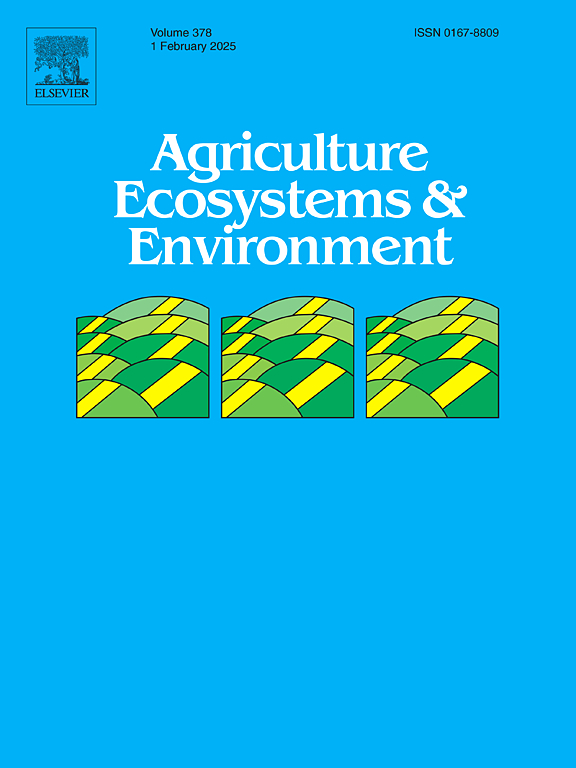Compensatory effect dominates the stabilizing effects of species asynchrony in semiarid grassland after N and P addition
IF 6
1区 农林科学
Q1 AGRICULTURE, MULTIDISCIPLINARY
引用次数: 0
Abstract
Semiarid grassland ecosystems on the Loess Plateau in China are constrained by persistent nitrogen (N) and phosphorus (P) limitations owing to historical soil erosion. N and P fertilization have a significant influence on grassland productivity and stability. However, the underlying mechanisms across different grassland community types remains poorly understood. A six-year split-plot field experiment was conducted to explore how N and P additions influence stability in short grass (SG) and tall forb (TF) communities, and to elucidate the roles of population stability (dominant or non-dominant species) and species asynchrony, specifically compensatory (CPE) and statistical-averaging (SAE) effects, in stabilizing the community. In SG community, the stability was jointly driven by species asynchrony (64.65 %) and population stability (35.35 %), with CPE accounting for 77.94 % of species asynchrony and dominant species stability contributing 91.84 % to population stability. The stability of the TF community was primarily driven by species asynchrony (84.40 %), with a major contribution from CPE (86.99 %). Overall, species asynchrony, particularly CPE, played a key role in stabilizing grasslands under N and P additions. However, SG and TF communities exhibiting divergent pathways. N and P additions destabilized CPE by shifting the dominant species composition in SG community and causing species richness decline in TF community. Fertilization strategies should prioritize moderate levels of N for the SG and low levels for the TF community to prevent biodiversity loss and promote long-term stability. Different community types were strongly influenced by the levels of N inputs, highlighting the need to integrate regional N deposition dynamics into fertilization strategies to achieve sustainable grassland restoration on the Loess Plateau.
氮磷添加对半干旱草地物种不同步的稳定作用以补偿效应为主
黄土高原半干旱草地生态系统受到历史土壤侵蚀造成的氮、磷持续限制。氮磷肥对草地生产力和稳定性有显著影响。然而,不同草地群落类型的潜在机制仍然知之甚少。通过6年的田间分块试验,探讨了氮磷添加对矮草(SG)和高草(TF)群落稳定性的影响,并阐明了种群稳定性(优势种和非优势种)和物种非同步效应,特别是补偿效应(CPE)和统计平均效应(SAE)在稳定群落中的作用。SG群落稳定性由物种不同步(64.65 %)和种群稳定(35.35 %)共同驱动,其中CPE占物种不同步的77.94 %,优势种稳定占种群稳定的91.84 %。群落稳定性主要受物种不同步驱动(84.40 %),主要受CPE驱动(86.99 %)。总体而言,物种不同步,特别是CPE,在N和P添加下稳定草地中发挥了关键作用。然而,SG和TF群落表现出不同的途径。N和P的添加通过改变SG群落的优势物种组成和导致TF群落的物种丰富度下降来破坏CPE的稳定。为防止生物多样性的丧失,促进群落的长期稳定,施肥策略应优先选择中等水平的氮用于荒漠植物群落,低水平的氮用于荒漠植物群落。不同的群落类型受N输入水平的强烈影响,突出了将区域N沉积动态纳入施肥策略以实现黄土高原草地可持续恢复的必要性。
本文章由计算机程序翻译,如有差异,请以英文原文为准。
求助全文
约1分钟内获得全文
求助全文
来源期刊

Agriculture, Ecosystems & Environment
环境科学-环境科学
CiteScore
11.70
自引率
9.10%
发文量
392
审稿时长
26 days
期刊介绍:
Agriculture, Ecosystems and Environment publishes scientific articles dealing with the interface between agroecosystems and the natural environment, specifically how agriculture influences the environment and how changes in that environment impact agroecosystems. Preference is given to papers from experimental and observational research at the field, system or landscape level, from studies that enhance our understanding of processes using data-based biophysical modelling, and papers that bridge scientific disciplines and integrate knowledge. All papers should be placed in an international or wide comparative context.
 求助内容:
求助内容: 应助结果提醒方式:
应助结果提醒方式:


